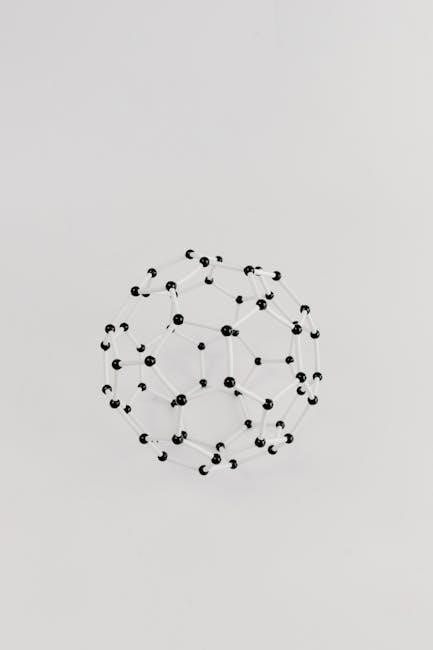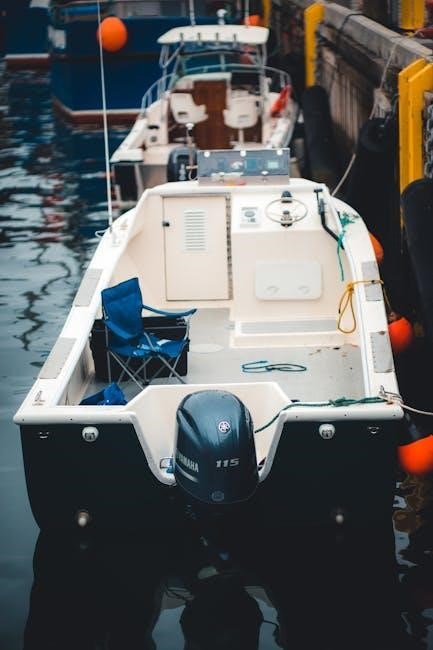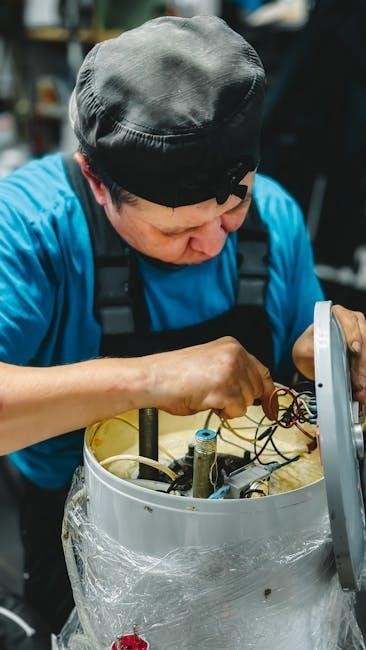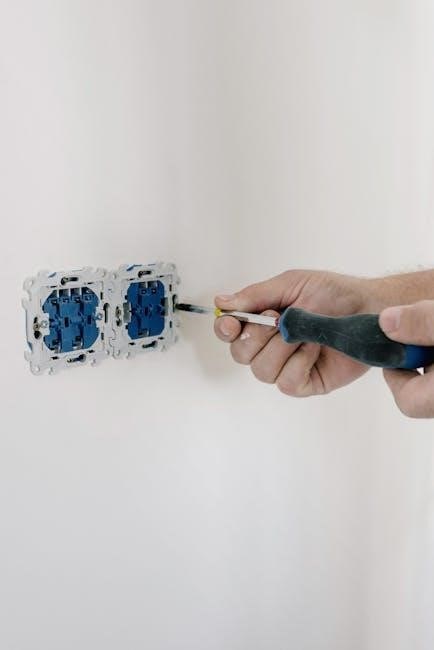Understanding the Basics of Yamaha Outboard Electrical Wiring
Yamaha outboard motors rely on precise electrical wiring for optimal performance. A wiring diagram is essential for understanding connections between components like alternators‚ starters‚ and gauges. Proper installation ensures reliability and safety‚ while incorrect wiring can lead to system failures. Always refer to the official Yamaha wiring diagram PDF for your specific model to avoid errors and ensure compatibility.
Importance of Proper Wiring for Yamaha Outboard Motors
Proper wiring is critical for the safe and efficient operation of Yamaha outboard motors. Incorrect or damaged wiring can lead to electrical fires‚ system failures‚ and even complete engine shutdown. A well-maintained wiring system ensures reliable communication between components‚ such as ignition switches‚ gauges‚ and fuel injectors. Improper connections can result in power loss‚ overheating‚ or malfunctioning sensors‚ which compromise performance and safety. Always refer to the official Yamaha wiring diagram PDF for precise instructions to avoid common mistakes. Correct wiring practices protect your investment‚ extend the motor’s lifespan‚ and ensure smooth operation on the water.
Key Components of Yamaha Outboard Electrical Systems
Yamaha outboard electrical systems consist of essential components that work together to ensure smooth operation. The battery provides power for starting and accessories‚ while the starter motor initiates engine ignition. The alternator charges the battery and powers electrical systems when the engine runs. Gauges‚ such as tachometers and fuel indicators‚ monitor vital engine functions. Wiring harnesses connect these components‚ ensuring proper communication and power distribution. The Electronic Control Unit (ECU) manages advanced functions like fuel injection and ignition timing. Connectors‚ fuses‚ and circuit breakers protect the system from overloads and short circuits. Understanding these components is crucial for interpreting wiring diagrams and maintaining your Yamaha outboard motor effectively.
Identifying Components and Symbols in the Wiring Diagram
Yamaha wiring diagrams use standardized symbols to represent components like batteries‚ starters‚ and gauges. Lines indicate wire connections‚ while circles or boxes denote junctions or connectors. Color-coded wires simplify tracing circuits‚ ensuring accurate diagnostics and repairs. Understanding these symbols is vital for interpreting the diagram effectively and maintaining your outboard motor’s electrical system.

Common Symbols and Their Meanings
Yamaha wiring diagrams utilize specific symbols to represent components. A battery is shown as two parallel lines with a plus and minus sign‚ while a starter motor is depicted as a circle with an “M” inside. Fuses and circuit breakers are illustrated with a zigzag line in a rectangle. Ground connections are marked with a down-pointing arrow‚ and switches are shown as a line with an angled break. These symbols‚ along with color-coded lines‚ help technicians and enthusiasts trace circuits and identify connections quickly. Familiarizing yourself with these symbols is crucial for accurate repairs and troubleshooting your Yamaha outboard motor’s electrical system effectively.

Color-Coding in Yamaha Outboard Wiring Diagrams
Yamaha wiring diagrams use color-coding to simplify identification of wire functions. Yellow wires typically represent the alternator output‚ while red wires denote positive battery connections. Black wires usually indicate ground or negative paths‚ and blue wires often connect to ignition systems. Green wires are commonly used for tachometer or sensor connections. Orange wires may signify fuel injection or other control systems. White wires often represent neutral or signal lines. Understanding these color codes is essential for tracing circuits and ensuring proper connections. This standardized approach reduces confusion and helps in diagnosing issues efficiently. Always refer to the official Yamaha wiring diagram PDF for accurate color mappings specific to your model.
Locating the Correct Yamaha Outboard Wiring Diagram
Find your Yamaha outboard motor’s serial number to access the correct wiring diagram. Visit Yamaha’s official website or consult an authorized dealer for accurate PDF diagrams tailored to your model.
How to Find Your Outboard Motor Serial Number
Locating the serial number on your Yamaha outboard motor is straightforward. It is typically found on a metal tag attached to the engine’s transom bracket or near the powerhead. The serial number is a unique sequence of numbers and letters crucial for identifying your motor’s specific model and year. This information is essential for accessing the correct wiring diagrams and other technical resources. Always ensure the serial number is visible and legible to avoid any delays in maintenance or repairs. Referencing this number on Yamaha’s official website guarantees you receive accurate and model-specific documentation.
Using Yamaha’s Official Website for Wiring Diagrams
Yamaha’s official website is the most reliable source for accurate wiring diagrams tailored to your outboard motor. By entering your motor’s serial number or model year‚ you can access detailed‚ model-specific diagrams. These diagrams are designed to simplify installation and troubleshooting‚ ensuring compatibility and safety. They often include color-coded wiring‚ component locations‚ and step-by-step instructions. Additionally‚ the site offers comprehensive guides and resources to help you understand and work with the electrical system. Always use official Yamaha resources to avoid errors and ensure your motor operates at peak performance. Regular updates and support make it an indispensable tool for DIY enthusiasts and professionals alike.

Troubleshooting Common Wiring Issues

Common wiring issues include short circuits‚ open circuits‚ and corroded connections. Use the wiring diagram to identify faulty components and test connections with a multimeter for quick resolution.

Identifying Faulty Components Using the Diagram
Use the wiring diagram to trace and identify faulty components in your Yamaha outboard electrical system. Start by comparing the diagram with your actual wiring setup to locate mismatches or damage. Visually inspect for signs of wear‚ corrosion‚ or burns. Test connections and components like fuses‚ relays‚ and sensors using a multimeter to confirm functionality. If a component fails to respond as indicated in the diagram‚ it may be faulty. Common issues include short circuits‚ open circuits‚ or corroded terminals. Once identified‚ replace or repair the faulty part to restore proper electrical flow. This method ensures accurate troubleshooting and prevents further system damage.
Common Mistakes to Avoid During Installation
When installing your Yamaha outboard electrical system‚ avoid common mistakes that can lead to malfunctions. Never skip consulting the wiring diagram‚ as incorrect connections can damage components. Ensure all wires are securely fastened to prevent chafing or water ingress. Avoid using incorrect gauge wires‚ as this can cause voltage drops or overheating. Always match wire colors to their designated functions‚ as color-coding is critical for proper operation. Do not overlook the use of heat shrink and dielectric grease to protect connections from corrosion. Lastly‚ never test the system without ensuring all connections are tight and properly insulated. These precautions ensure a safe and reliable electrical setup.

Installation Best Practices
Always use heat shrink and dielectric grease for secure‚ corrosion-resistant connections. Follow the wiring diagram precisely‚ ensuring proper color-coding and wire gauge usage. Secure all wires neatly to prevent chafing and water exposure. Test the system thoroughly before finalizing connections to ensure everything functions correctly.
Step-by-Step Guide to Wiring Your Yamaha Outboard
- Gather tools: multimeter‚ wire cutters‚ crimpers‚ and heat shrink tubing.
- Disconnect the battery to prevent accidental power surges.
- Refer to the Yamaha wiring diagram PDF for your specific motor model.
- Identify and label wires using the color-coding guide provided.
- Connect power wires to the battery and alternator first.
- Install gauges and sensors‚ ensuring proper grounding.
- Connect ignition and start/stop circuits carefully.
- Test each connection with a multimeter before finalizing.
- Apply heat shrink and dielectric grease for protection.
- Reconnect the battery and perform a full system test.
Following these steps ensures a safe and reliable wiring setup for your Yamaha outboard motor.
Using Heat Shrink and Dielectric Grease for Connections
Heat shrink tubing and dielectric grease are essential for protecting and sealing electrical connections in Yamaha outboard wiring. Heat shrink provides insulation‚ preventing moisture and abrasion damage‚ while dielectric grease ensures optimal conductivity and prevents corrosion. Apply grease to connectors before assembling‚ then use heat shrink to cover exposed wires. This combination enhances durability and reliability in marine environments. Properly sealed connections reduce the risk of electrical failures and ensure long-term performance. Always follow the wiring diagram for specific applications and use high-quality materials to maintain the integrity of your Yamaha outboard electrical system.

Safety Precautions When Working with Electrical Systems
Always disconnect power before working on electrical systems to prevent shocks. Use a multimeter to verify live circuits and ensure proper insulation of all connections to avoid accidents.

Essential Safety Tools and Practices
When working with Yamaha outboard electrical systems‚ essential safety tools include insulated pliers‚ multimeters‚ and heat-resistant wire strippers. Always disconnect the battery and verify no power is present using a multimeter to prevent shocks. Wear protective gear like gloves and safety goggles to avoid injuries. Use heat shrink tubing and dielectric grease for secure‚ moisture-proof connections. Ensure all tools are properly rated for marine environments to prevent corrosion; Keep a fire extinguisher nearby and avoid working in confined spaces with poor ventilation. Regularly inspect wires for damage and replace worn components to prevent electrical fires. Follow Yamaha’s official guidelines for safe practices.

Preventing Electrical Fires and Short Circuits
To prevent electrical fires and short circuits in your Yamaha outboard system‚ ensure all connections are secure and waterproof. Use heat shrink tubing and dielectric grease to protect wires from moisture and corrosion. Avoid overloading circuits‚ as this can cause excessive heat buildup. Regularly inspect wiring for signs of damage‚ such as frayed cords or chafed insulation‚ and replace any compromised components promptly. Keep the battery terminals clean and tightly secured to prevent arcing. Avoid using incorrect gauge wires‚ as this can lead to resistance and overheating. Always follow Yamaha’s wiring diagram PDF for your specific model to ensure connections are correct and safe.
